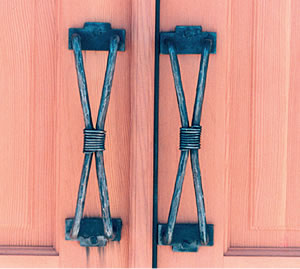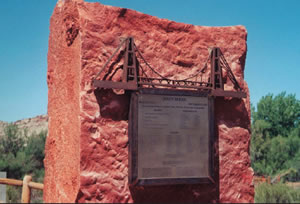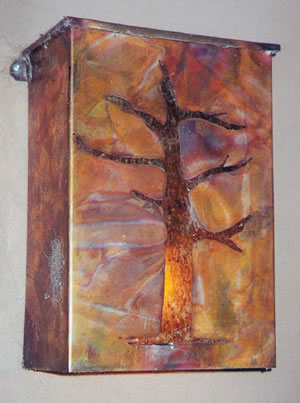Moab Utah artists. Moab is home to many local artists and nationally known artists. These talented people work in a range of mediums from visual arts through literary to musical. Each month Moab Happenings features one of our talented local Moab artists. Artist of the Month - June 2004 The Iron Man
of Moab |
 The
modern image of an iron man is one who can outrun, -bike
and -swim his opponents in an endurance race. The iron man
of Moab is just as impressive in his feats but in a far more
traditional sense of the name; he is a metal works artist. Tom
Stengel combines the time-honored methods of blacksmithing
with contemporary techniques of welding to create original
eye-catching art. The
modern image of an iron man is one who can outrun, -bike
and -swim his opponents in an endurance race. The iron man
of Moab is just as impressive in his feats but in a far more
traditional sense of the name; he is a metal works artist. Tom
Stengel combines the time-honored methods of blacksmithing
with contemporary techniques of welding to create original
eye-catching art.By heating iron and other metals to red, yellow and white hot temperatures, Stengel manages to mold them like clay into graceful curves and twists. The beauty of working metal goes beyond its physical aesthetics. The artful shapes belie the strength of the medium; it is difficult to believe that soft contours can be made out of such a hard substance. Stengel has mastered the craft of shaping various metals, brass, copper, steel and tin, into art forms over the past decade. What started as a one-time project evolved into a full-blown passion. In 1994, Stengel, an avid bicyclist at the time, wanted to donate bike racks to his church and the local library. Because he couldn’t find a welder to create the racks, he convinced a bike frame builder to weld them together. After watching the process, Stengel was intrigued by it. He traveled to Durango, Colorado, for an arts festival, where he met and visited with Mike Boone, a blacksmith from Paonia. Boone invited Stengel to work with him for a day and at the end declared that Stengel “had the knack for it.” That was enough encouragement to galvanize Stengel into joining the state and national organizations for blacksmiths, the Bonneville Forge Council and the Artists Blacksmith Association of North America, respectively.  After attending several week-long programs where he learned basic metal
working techniques such as creating 90° angles, circles and bean-shaped
door handles, he built his own shop, located next door to his lovely
adobe home, accented with burnished metal sconces made by Stengel himself. After attending several week-long programs where he learned basic metal
working techniques such as creating 90° angles, circles and bean-shaped
door handles, he built his own shop, located next door to his lovely
adobe home, accented with burnished metal sconces made by Stengel himself.Ever since he discovered blacksmithing, it has been Stengel’s passion. While showing me around the one-room office attached to the shop, he admits that he “built the shop before the house,” and adds that as a consequence, “I, my wife, Suzie, and our two daughters had to live in this one room while the house was being built.” Suzie has truly been a supporter and partner in his venture to create Desert Iron, the name they have given to Tom’s studio and business. The iron logo Stengel forged symbolizes this harmonious, balanced union between them by representing two birds facing each other within a perfect circle. Desert Iron’s success can be measured in the number of metal artworks Stengel has displayed around town. Over the years, he has been commissioned by local residents to create a variety of objects, which include railings, banisters, gates and signs. Each piece Stengel creates displays his aesthetic ability and dexterity with the un-yielding medium he uses. The lush-looking grapes and vines he sculpted for the restaurant, Pasta Jay’s, reflects his craft in replicating the graceful curves and textures found in nature. The signs he produced for Dewey Bridge which sport a replica of the cable bridge are testament to his ability to work with detail and recreate realistic depictions.  Although Stengel doesn’t call himself soley a blacksmith because
he uses modern techniques like welding along with forging, he retains
many of the traditional methods and tricks of the trade. An example is
the Blacksmith’s Cross, a four prong cross molded out of one rod
of metal. Stengel makes two long perpendicular cuts into the rod and
twists the prongs out, leaving a diamond-shaped hole at the center. Despite
the look of complex twists, the cross has no welded pieces to it. Although Stengel doesn’t call himself soley a blacksmith because
he uses modern techniques like welding along with forging, he retains
many of the traditional methods and tricks of the trade. An example is
the Blacksmith’s Cross, a four prong cross molded out of one rod
of metal. Stengel makes two long perpendicular cuts into the rod and
twists the prongs out, leaving a diamond-shaped hole at the center. Despite
the look of complex twists, the cross has no welded pieces to it.Stengel demonstrated his talent for forging, welding and repoussé (a method for making relief contours) when he was commissioned to recreate a family’s crest in copper. He expertly depicted oak leaves, a knight, a bird and a shield and unified the elements into a dignified, breath-taking crest now decorating the family’s front gate. He has manipulated metal into an astounding assortment of uses and objects, which include sofa tables with long, spindly legs, clocks, a cribbage board, bow-tie handles and ornate locks for doors. Stengel plays magic with metal rods, bending, twisting and coaxing them into a variety of forms, each one displaying his aesthetic sense.  Getting a demonstration from Stengel in his blacksmith shop is like watching
fireworks. Anticipation builds in the air when he stands at his forge,
bellowing air through the chimney to increase the heat that softens the
metal rod buried in coals. Getting a demonstration from Stengel in his blacksmith shop is like watching
fireworks. Anticipation builds in the air when he stands at his forge,
bellowing air through the chimney to increase the heat that softens the
metal rod buried in coals. After several minutes pass and he deems the metal hot enough to work with, he quickly extracts the rod from the forge and moves it to the gleaming three hundred pound anvil where in quick bursts he expertly hammers, sending sparks called “scales” flying. The noise and tremor of the pounding combine with the heat and intense energy to create a monumental display of strength and endurance. The translucent red glow of the rod quickly fades to black, leaving the steel too hard to manipulate, although it remains at a temperature above 1800°. This need for quick action once the metal is out of the forge explains Stengel’s credo, “think in the fire, work at the anvil.” He uses the brief lulls while the fire heats the metal to plan his next step. Once he extracts the metal, the process demands decided action. Each pound of the hammer leaves a mark, not easily erased. Yet, in order to leave a mark, the hammering has to be forceful. Clearly, blacksmithing is not a craft for the faint-of-heart. Along with creative talent, it is an art that demands the physical endurance and mental acumen of a marathoner. |